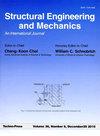Unified calculation model for the longitudinal fundamental frequency of continuous rigid frame bridge
IF 3
4区 工程技术
Q2 ENGINEERING, CIVIL
引用次数: 0
Abstract
The frequencies formulas of the bridge are of great importance in the design process since these formulas provide insight dynamic characteristics of the structure, which guides the designers to parametric analyses and the layout of the bridge in conceptual or preliminary design. Continuous rigid frame bridge is popular in the mountainous area. Mostly, this type of bridge was simplified either as a girder or cantilever when calculating the frequency, however, studies showed that the different configuration of the bridge made the problem more complex, and there is no unified fundamental calculation pattern for this kind of bridge. In this study, an empirical frequency equation is proposed as a function of pier's height, stiffness of pier and the weight of the structure. A unified fundamental frequency formula is presented based on the energy principle, then the typical continuous rigid frame bridge is investigated by finite element method (FEM) to study the dynamic characteristics of the structure, and then several key parameters are investigated on the effect of structural frequency. These parameters include the number, position and stiffness of the tie beam. Nonlinear regression analyses are conducted with a comprehensive statistical study from plenty of engineering structures. Finally, the proposed frequency equation is validated by field test results. The results show that the fundamental frequency of the continuous rigid frame bridge increases more than 15% when the tie beams are set, and it increases with the stiffness ratio of tie beam to pier. The results also show that the presented unified fundamental frequency has an error of 4.6% compared with the measured results. The investigation can predicate the approximate longitudinal fundamental frequency of continuous ridged frame bridge, which can provide reference for the seismic response and dynamic impact factor design of the pier.连续刚构桥纵向基频统一计算模型
桥梁的频率公式在设计过程中具有重要意义,因为这些公式提供了结构的动态特性,指导设计者在概念设计或初步设计中进行参数化分析和桥梁布置。连续刚构桥在山区很流行。在计算频率时,这种类型的桥梁大多简化为主梁或悬臂,但研究表明,桥梁的不同结构使问题更加复杂,并且没有统一的基本计算模式。本文提出了桥墩高度、桥墩刚度和结构自重的经验频率方程。基于能量原理,提出了统一的基频计算公式,并对典型连续刚构桥进行了有限元分析,研究了结构的动力特性,分析了几个关键参数对结构频率的影响。这些参数包括系梁的数目、位置和刚度。对大量工程结构进行了非线性回归分析,并进行了全面的统计研究。最后,通过现场试验验证了所提出的频率方程。结果表明:设置系梁时,连续刚构桥的基频增大15%以上,且随系梁与桥墩刚度比的增大而增大;结果还表明,所提出的统一基频与实测结果相比误差为4.6%。研究结果可预测连续刚构桥的近似纵向基频,为桥墩的地震反应和动力影响系数设计提供参考。
本文章由计算机程序翻译,如有差异,请以英文原文为准。
求助全文
约1分钟内获得全文
求助全文
来源期刊

Structural Engineering and Mechanics
工程技术-工程:机械
CiteScore
3.80
自引率
18.20%
发文量
0
审稿时长
11 months
期刊介绍:
The STRUCTURAL ENGINEERING AND MECHANICS, An International Journal, aims at: providing a major publication channel for structural engineering, wider distribution at more affordable subscription rates; faster reviewing and publication for manuscripts submitted; and a broad scope for wider participation.
The main subject of the Journal is structural engineering concerned with aspects of mechanics. Areas covered by the Journal include:
- Structural Mechanics
- Design of Civil, Building and Mechanical Structures
- Structural Optimization and Controls
- Structural Safety and Reliability
- New Structural Materials and Applications
- Effects of Wind, Earthquake and Wave Loadings on Structures
- Fluid-Structure and Soil-Structure Interactions
- AI Application and Expert Systems in Structural Engineering. Submission of papers from practicing engineers is particularly encouraged.
 求助内容:
求助内容: 应助结果提醒方式:
应助结果提醒方式:


